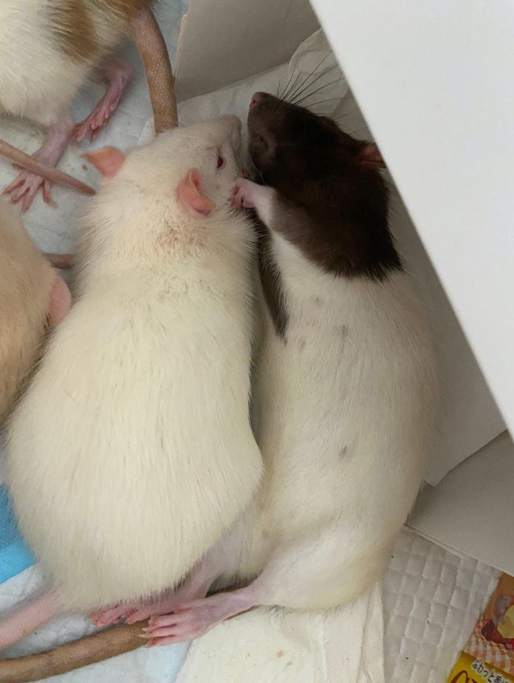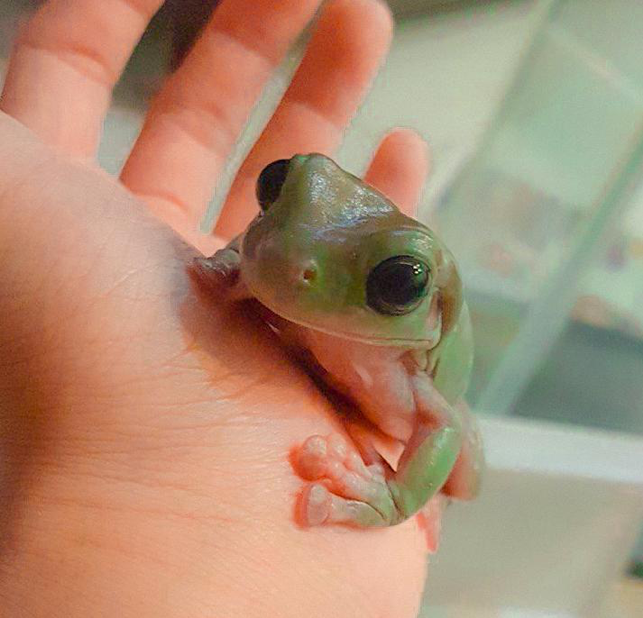The Bizarre World Of Singapore’s Peculiar Pets
Forget puppies, kittens and hamsters, let’s talk frogs, rats and shrimps. The HYPE team chats with three different owners who own these very unconventional pets.
BY
BENJAMIN WELLESLEY
Main Editor of HYPE Issue #51
JOJO TUNG
People Editor of HYPE Issue #51
FREDERICK LAW
Editorial Admin of HYPE Issue #51
Published on
December 25, 2020
To many, a dog is a man’s best friend. But to others, a rat is theirs. There’s an allure about unconventional pets that makes people gravitate towards them, so read on and discover why some are rearing these legal oddball pets in Singapore!
Cong-rats! A Surprisingly Ratical Companion

A pair of Isabel’s beloved rats, which she chooses to keep unnamed. As nocturnal creatures, they come alive past midnight, scurrying and jumping around in their cage. Photo courtesy of Isabel Hong.
The sight of these critters is usually accompanied by a shriek of disgust. Condemned as pesky, repulsive vermin, rats are shunned by the general populace who would much prefer to never encounter them.
On the contrary, final-year Ngee Ann Polytechnic student Isabel Hong, 18, thinks otherwise. The proud owner of four rats relishes having them as her rodent companions, meticulously caring for them daily.
“If well socialised, [rats] don’t mind being handled. This means that they warm up easily to humans and enjoy our companionship and attention. Compared to hamsters, they are more intelligent and can be taught tricks easily, and have different personalities,” says Isabel.
After stumbling across Instagram accounts run by rat breeders and owners showcasing their very own rodents, Isabel did her research before purchasing her first pair in Jul 2019. “Rats are social creatures so they have to be bought in pairs,” she explains. Shortly after, she purchased her second pair in Nov 2019.
Isabel’s rodent quartet have unique and quirky personalities that spruce up her daily life. “One of my rats is the smartest one of the group and masters tricks easily, while the other is lazy and spends her time sleeping or waddling around,” she adds.
Video courtesy of Isabel Hong.
Integrated into her daily routine, Isabel and her kindred rats are inseparable. “Throughout the day, I will just carry one of them on my shoulder as I do my daily tasks and I will feed them treats in exchange for a spin (a trick Isabel taught them),” Isabel said.
Like taking care of any other pet, a lot of dedication is required. Isabel has to clean the rats’ cage daily, performing a deep clean every week to get rid of shed hair, little food crumbs and ensure their toys and boxes are squeaky clean. For her rats’ diet, she makes regular orders for lab blocks on Shopee due to the scarcity of food sources in Singapore.
Despite the rigorous commitment, the allure of owning these rats has not faded for Isabel. She says: “They are very lovable creatures because they warm up to you quickly and get excited every time they hear you approaching. They are like puppies in a sense.”
Kermit-ting To A Hoppin’ Good Time
Commonly sighted in Generation Z’s stash of sticker packs and memes, frogs have experienced a meteoric rise in popularity as they take on forms of the iconic muppet Kermit and Pepe the Frog. For many frog owners, the moment of glory to show off their unique webbed feet companions has come.
“Frogs are very cute and special. They don’t have an emotional connection with you like dogs and cats so it tends to be more one-sided, but then again that’s the same with terrapins and fishes,” says Jolene Ng, 19, who brought home a green tree frog in 2017.
Since I’ve owned more common pets like dogs before, I wanted to try caring for something new. I also knew I was passionate about the vet industry so I decided to learn more about amphibians.
Currently pursuing a Diploma in Veterinary Bioscience, the final-year Ngee Ann Polytechnic student says: “Since I’ve owned more common pets like dogs before, I wanted to try caring for something new. I also knew I was passionate about the vet industry so I decided to learn more about amphibians.”
Frogs surfaced as the perfect pet for the then secondary three students, given its low cost and maintenance. Purchasing her frog for S$30, she spent S$20 on its glass tank and another S$10 on fake branches to beautify its habitat.

Kermit, the green tree frog, makes for a peculiar companion and has a life expectancy of up to 16 years. Photo courtesy of Jolene Ng.
With big, bulging eyes and pickle green exterior, Kermit now nestles cosily in a corner of Jolene’s living room. The docile creature leads a plain sailing life, feeding on its favourite live crickets every two days and sleeping its afternoons away on a branch. Despite its nocturnal nature, Kermit lets out only soft croaks during the night.
As widely adored as they are, few would be keen on having frogs as pets. Jolene says: “Many people are afraid and don’t dare to interact with frogs. When I first brought it home, my family thought it was gross but after a while, they got used to it.”
While many would shriek at the thought of handling live insects, feeding Kermit with crickets and mealworms happens to be Jolene’s favourite interaction with her pet. “I can’t bring frogs out on walks and they cannot stay out of their habitat for long periods of time so the most I can do is talk to him, sayang him, snap some pictures then put him back.”
“They won’t reciprocate or anything but it’s special and unique company to have, especially since they can live up to 16 years,” she says, adding that frogs, of all animals, are her favourite to take care of.
Shrimp Pimps
These tiny freshwater crustaceans have a lifespan of about two years, and only grow to about 2cm in size. Despite this, shrimp like the ‘Black Fancy Tiger’ can cost up to S$4,500 for a breeding pair. Fancy indeed.
The allure of rearing ornamental shrimp lies in creating new patterns or colours by selectively breeding different shrimp together. Generally, the harder it is to achieve a certain pattern or colour, the higher the asking price.
Bene Tay, is an avid ornamental shrimp-keeper and blogger. According to him, ornamental shrimp keeping as a hobby has been around in Singapore for a decade or so.
However, he estimates the number of “serious shrimp hobbyists” globally to be around 4,000 to 5,000 people. The small size of the community attests to the difficulty of keeping the delicate shrimp.
Ornamental shrimp are found in the wild in pure mountain springs, where the water is so clean it’s drinkable. As such, the shrimp require water temperatures of between 18 deg C and 26 deg C to thrive.
Hobbyists recreate their natural environmental conditions by purchasing Reverse Osmosis Deionised (RODI) filters to filter out harmful chemicals and pollutants such as chlorine, ammonia, lead and copper from tap water. These RODI filters cost anywhere from S$100 to S$400, depending on the rate and volume of water the filters can purify. Hobbyists also install water chillers to maintain aquarium water temperatures below 26 deg C, and these chillers cost S$300 to S$2,000.
Although the barrier to entry is considerably higher when compared to purchasing a furry companion, “shrimps are easy to keep and do not require a lot of maintenance once established… I don’t have to worry much even when I’m away,” says Mr Tay, who works a regional job that requires him to be abroad half the time.
As he travels often, he has had the opportunity to meet many shrimp-keepers around the world, including renowned Taiwanese shrimp breeder Hwa. According to Mr Tay, he “travelled to Taiwan to learn first-hand from him (how to breed shrimp) and bring the knowledge back to Singapore to share it with other hobbyists.”
So if you’re not a dog or cat person and fancy standing out a little, try housing a pair of rats, frogs, or shrimp. But if you seek something more exotic, living abroad might be your best bet.
I feel that this has been a good initiative introduced by the management, as it helps all the freshies to get [an] idea of how to speak on-air and converse with each other.
In order to preserve Singapore’s biodiversity, many exotic pets like tarantulas and snakes are illegal to own and offenders can be fined up to S$50,000.
Despite this, there is a thriving underground market for reptiles such as snakes, bearded dragons, and even caimans here. Big cats like tigers or clouded leopards have even been sold on Singapore shores. In fact, wildlife trade monitoring network Traffic has ranked the Republic of Singapore as one of the top ten wildlife smuggling hubs in the world.
So technically, yes, there are all sorts of animals out there waiting for you on this tiny, tropical island. Just try not to take them home.

Your article helped me a lot, is there any more related content? Thanks!
I have read your article carefully and I agree with you very much. This has provided a great help for my thesis writing, and I will seriously improve it. However, I don’t know much about a certain place. Can you help me? https://www.gate.io/signup/XwNAU
แนะนำ เกมดี ระบบเด่น ถอนไวใน 8 วินาที ไม่ต้องรอแอดมิน <a href=”https://betflix688.com/” title=”เบทฟิก68″>เบทฟิก68</a>
Thanks for sharing. I read many of your blog posts, cool, your blog is very good.
Jili Slot ท้าให้ลอง สล็อตแตกง่าย เครดิตฟรีหน้าเว็บ เกมดี สนุกมาก ค่ายเกมฮิตอยู่ในนี้ เว็บเดียวจบ ทดลองเล่นฟรี มีโปรโมชั่นมากมาย กับสล็อตออนไลน์ แจกฟรีสปิน ลองแล้วจะติดใจ
Betflik999 ปรับแตกง่ายทุกยูสคืนยอดเสีย 3%ทุกวันไม่อั้นถอนไม่มีขั้นต่ำไม่จำกัดจำนวนครั้งทดลองเล่นฟรีเกมฮิตเกมดังเล่นง่ายมือใหม่เล่นได้กำไรดี
I don’t think the title of your article matches the content lol. Just kidding, mainly because I had some doubts after reading the article.
Your point of view caught my eye and was very interesting. Thanks. I have a question for you.
Your article helped me a lot, is there any more related content? Thanks!
I don’t think the title of your article matches the content lol. Just kidding, mainly because I had some doubts after reading the article.
Can you be more specific about the content of your article? After reading it, I still have some doubts. Hope you can help me.